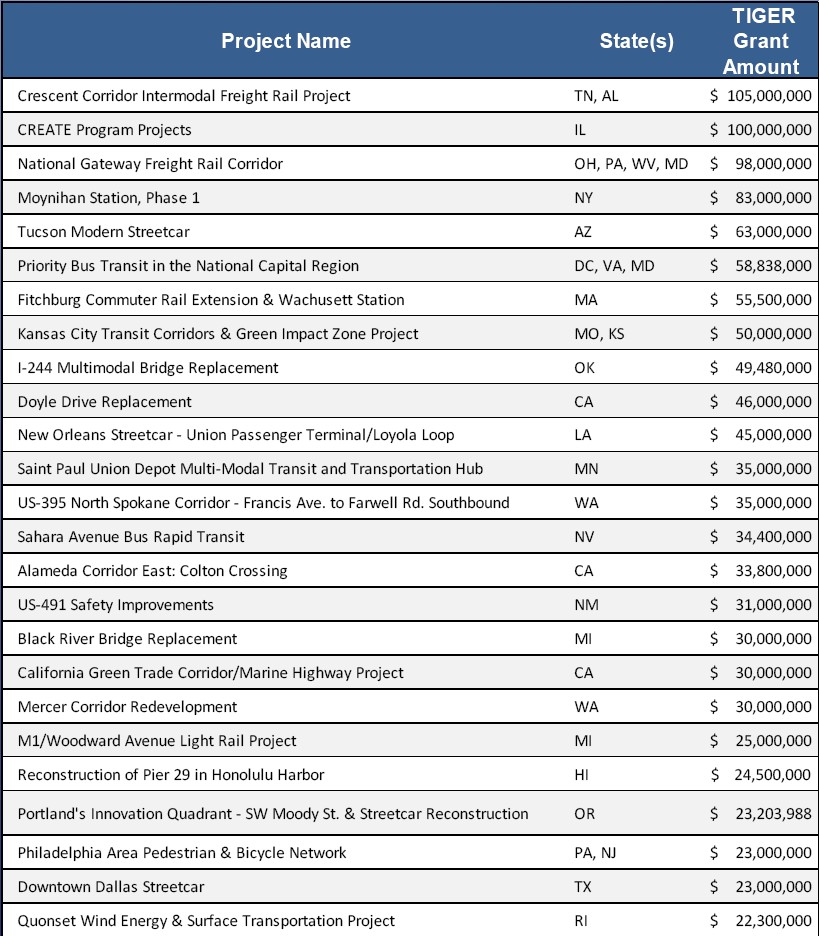Tom McNamara, Blueprint America
The U.S. Department of Transportation (DOT) announced on Wednesday the winning projects to be funded under their Transportation Investment Generating Economic Recovery (TIGER) grant program, which was created to oversee the dispersal of $1.5 billion included in the stimulus plan a year ago. In other words, a bureaucracy within a bureaucracy. While the DOT’s function is to oversee the flow of transportation dollars from Washington, the TIGER program’s function is to do it better (as it relates to stimulus funding and as it relates to finally using an acronym that is also Transportation Secretary Ray LaHood’s nickname).
 President Barack Obama with Transportation Secretary Ray LaHood || photo: White House / streetsblog.org President Barack Obama with Transportation Secretary Ray LaHood || photo: White House / streetsblog.org |
The TIGER program put in place specific criteria designed to reward states and cities that came up with “great projects” that, under normal transportation funding laws and requirements, would otherwise have been overlooked. “TIGER grants will tackle the kind of major transportation projects that have been difficult to build under other funding programs,” said Sec. LaHood. “This will help us meet the 21st century challenges of improving the environment, making our communities more livable and enhancing safety, all while creating jobs and growing the economy.”
Outside of an earmark by a member of Congress, a typical transportation project is funded and selected according to formulas based on, among other things, population of an area, whether it is rural, urban or in-between, whether it is for highways (projects benefiting personal automobile transportation) or mass-transit (everything else), if there are matching local funds, if it is “shovel-ready,” and so on. In most cases, the merit of the project has nothing to do with it — it is a numbers game. And the number transportation advocates, be it for the open road or the fixed-rail, most often call on is 80/20 — 80 percent of federal transportation funding goes to highways while 20 percent goes to mass-transit. The DOT has in recent years tried to shift the focus of roads over rail through programs such as “New Starts” and “Small Starts,” which favor small, mass-transit oriented projects. While the TIGER program will still fund highway building, it continues a growing trend in Washington to find ways to award new-transit, especially if it is “green.”
The DOT, not surprisingly, was flooded with more than 1,400 applications from all 50 states, territories and the District of Columbia requesting funding for almost $60 billion worth of projects — 40 times the amount available through the TIGER program.
In the end, 51 projects were selected:
· Modern streetcar construction to support vibrant urban corridors in Tucson, Dallas, Portland and New Orleans and light rail in Detroit;
· Bridge replacements in Oklahoma, Michigan, Wisconsin, Kentucky and Indiana that can support multiple modes of travel;
· Port and freight-rail projects to spur economic growth in Tennessee, Alabama, Mississippi, Virginia, Hawaii, Pennsylvania and Ohio;
· Innovative highway funding and operations in Texas, North Carolina, Colorado, South Carolina and Arkansas;
· Bicycle and pedestrian networks in Philadelphia, Indianapolis, and a complete streets project in Dubuque, IA;
· The long-awaited rebirth of New York’s former Penn Station as Moynihan Station.




